My Trip to the DMZ
Living in South Korea has this cool perk whereby it's attached to a totalitarian country run by 'The Dear Leader.' As such, visiting the demilitarized zone between North and South Korea was more exciting than any palace tour!
First, we went to the Military Armistace Commission Building. This is the little blue negotiating room through which the military demarcation line passes. On one side of the table lies South Korea; on the other, North. We could walk around the table to the other side of the room, but were warned not to pass this guy guarding the door to North Korea:
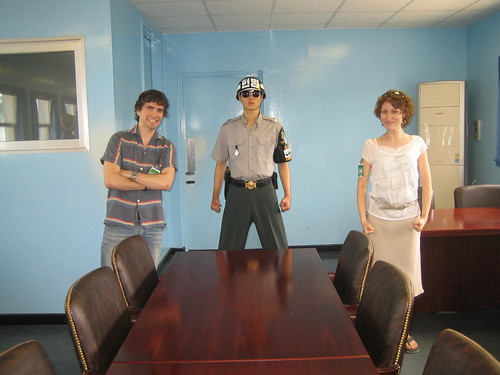
Here's an arial view of the same building I grabbed from Google Earth. It's the blue building in the centre. The big building to the north is North Korea's Panmungak, and to the south is South Korea's Freedom Building. The tension is definitely palpable in this area. Many areas where gunfire or death occured were pointed out.
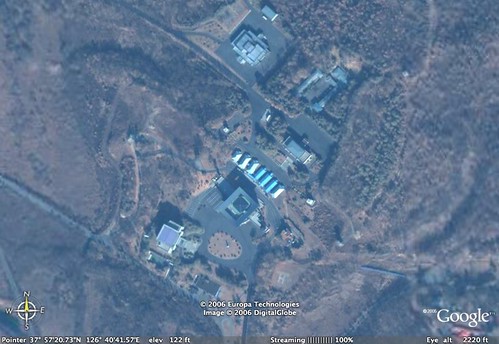
Both our US Military tourguide and Korean tourguide regaled us with stories to highlight the stupidity, disrespect or brutality of the North. Stupidity: N. Korea dug many tunnels in the 70's towards S. Korea, 10 of which S. Korea discovered. N. Korea then said they were to mine gold or coal, though everyone knows the rock in the area is pure granite. Disrespect: When U.S. dignitaries visited the Military Armistace Commission Building, N. Korean guards took down the US flag and polished their boots with it. As such the flags no longer exist in the building. Brutality: The 1976 Axe Murder. During a routine tree-trimming, N. Korean soldiers grabbed the axe and killed two U.S. soldiers.
Next, we went up to Checkpoint #3. From this elevated area, we could see a heckuvalot: Propaganda village with the 160 M flagpole (built so that it would be 60 M taller than S. Korea's), the Bridge of No Return, radio towers designed to jam signals to keep the minds of N. Korean's as innocent as babies', many watchtowers (no doubt filled with North Koreans watching our every move) and a lush green strip of no-man's land that, due to being untouched for 50 years, has some of the most diverse wildlife in Korea.
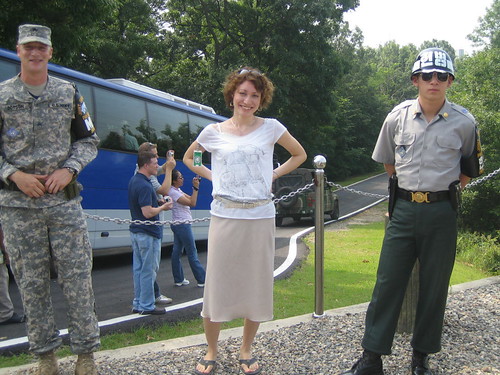
Here is Propaganda Village. If you squint, you can see the large flagpole in the haze. You can also see the lush foliage of no-man's land that exists between the north and south:
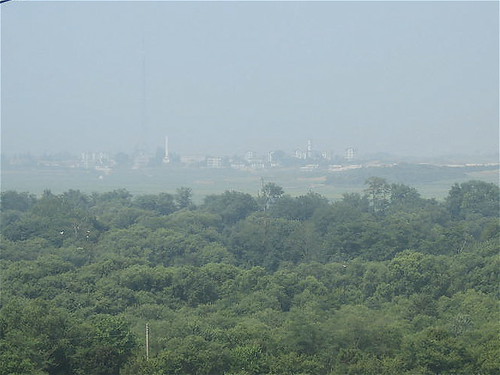
Next, we passed by the site of the 1976 axe murder, which bore this memoir (click to read):

Next to this lay the only bridge connecting the north and south. It is called the Bridge of No Return because after the war, prisoners were given the choice to go back to their country, but could never return. During this part of the trip, we were obviously not allowed out of the bus, to prevent the hassle of a shootout lest someone decide to defect.
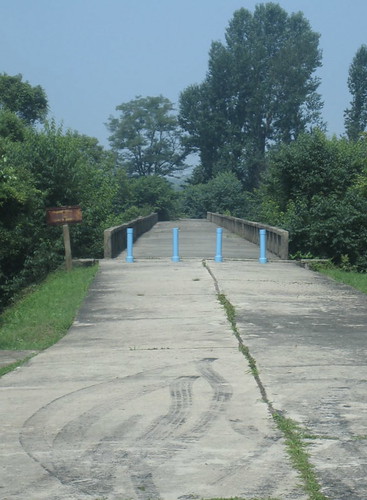
After a surprisingly simple yet good lunch of bimbimbap or bulgogi..

..we drove for an extended time, bordered on both sides by forests filled with landmines, until we reached the Dora Observatory, a big building on a very high hill overlooking North Korea. We arrived at the same time as a group of war veterans, some of whom hailed from the U.S. and spoke fluent English (shocking!).

Dropping a 500 won coin into the binoculars at this observatory allows one to zoom in on Propaganda Village, surrounding farmland, and an industrial area in North Korea. We were able to see farmers or soldiers walking around on the dirt roads. After being rendered giddy by the joys of spying on North Korean laypeople, we were whisked over to the 3rd Infiltration Tunnel, one of the many tunnels N. Korea dug in hopes of springing a surprise attack on the south.

I love tunnels and mines, so this was a definite highlight. This particular tunnel has been turned into a full tourist attraction, with a modern building leading into a long cement-lined shaft with seats for resting weary limbs. After walking for 5 or 10 minutes, you arrive at an intersection, and then continue walking down the actual tunnel dug by the N. Koreans. This tunnel is darker, narrower, about 2m x 2m. It requires walking like a hunched over jinja harmony (great grandmother) to prevent hitting your head on the rock. The tunnel is cold, dripping wet, and lined with dark soot. I didn't really understand through the guide's thick accent, but from what I gathered, the N. Koreans painted it with soot to create the facade that they were mining coal.
Next, we arrived at Dorasan Station, which connects the north to the south by rail. S. Korea built it in hopes of reunification. The N. Korean portion of the line exists, but they have yet to officially open their tracks for use.
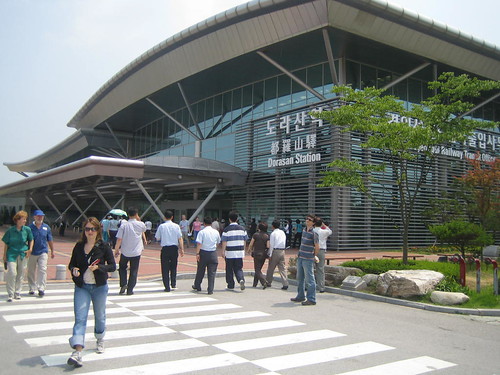
While standing inside, we noticed a bunch of schoolkids clamber through the gates in the arrival area. We thought perhaps they had gone to North Korea, but perhaps they just saw the train and tracks that lead there. One of them yelled something and grabbed the white-gloved hands of one of the normally stoic guards, who cracked a smile.
We then toured a giftshop, where one can by pieces of fence that were taken down between the two Koreas. Brent bought some tea made in North Korea. And before we knew it, we were driving back through the various checkpoints, past the intricate roadblock artforms, back to Seoul.
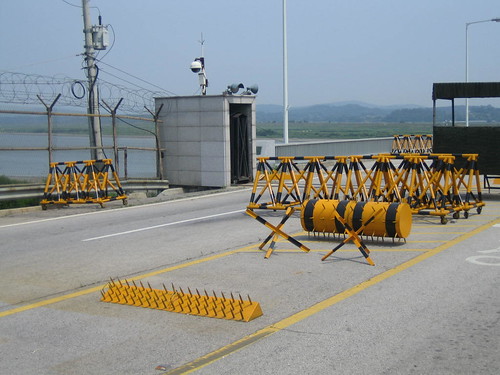
Upon returning home.. err, 'home' to Daegu, I've been once again obsessed with reading up on North Korea. I'd hate to write a blog entry that leaves one with the biased idea that North Korea is the 'axis of evil.' In fact, despite the obvious sins like starving people, North Korea does seem to have a lot of positive virtues, especially after reading this Russian's account of his trip there: Click Here..
The people seem to support themselves well and live humble lives in a land that resembles eastern Europe. The streets are kept immaculately clean, and people share a sense of responsibility to keep their city looking pristine. Corporate advertising exists nowhere. There is little crime. They live like South Koreans did many years ago.. for example, heating their houses by an underground tunnel attached to a burning pit. Fields are plowed by oxen, profit is split by cooperatives, and the scenery is actually quite beautiful, lacking the highways, cement and neon lights of South Korea. Rather than playing computer games, kids spend their time honing their music and dance abilities. In a way, The Dear Leader has reached the utopian goals he set out to achieve.
First, we went to the Military Armistace Commission Building. This is the little blue negotiating room through which the military demarcation line passes. On one side of the table lies South Korea; on the other, North. We could walk around the table to the other side of the room, but were warned not to pass this guy guarding the door to North Korea:

Here's an arial view of the same building I grabbed from Google Earth. It's the blue building in the centre. The big building to the north is North Korea's Panmungak, and to the south is South Korea's Freedom Building. The tension is definitely palpable in this area. Many areas where gunfire or death occured were pointed out.

Both our US Military tourguide and Korean tourguide regaled us with stories to highlight the stupidity, disrespect or brutality of the North. Stupidity: N. Korea dug many tunnels in the 70's towards S. Korea, 10 of which S. Korea discovered. N. Korea then said they were to mine gold or coal, though everyone knows the rock in the area is pure granite. Disrespect: When U.S. dignitaries visited the Military Armistace Commission Building, N. Korean guards took down the US flag and polished their boots with it. As such the flags no longer exist in the building. Brutality: The 1976 Axe Murder. During a routine tree-trimming, N. Korean soldiers grabbed the axe and killed two U.S. soldiers.
Next, we went up to Checkpoint #3. From this elevated area, we could see a heckuvalot: Propaganda village with the 160 M flagpole (built so that it would be 60 M taller than S. Korea's), the Bridge of No Return, radio towers designed to jam signals to keep the minds of N. Korean's as innocent as babies', many watchtowers (no doubt filled with North Koreans watching our every move) and a lush green strip of no-man's land that, due to being untouched for 50 years, has some of the most diverse wildlife in Korea.

Here is Propaganda Village. If you squint, you can see the large flagpole in the haze. You can also see the lush foliage of no-man's land that exists between the north and south:

Next, we passed by the site of the 1976 axe murder, which bore this memoir (click to read):

Next to this lay the only bridge connecting the north and south. It is called the Bridge of No Return because after the war, prisoners were given the choice to go back to their country, but could never return. During this part of the trip, we were obviously not allowed out of the bus, to prevent the hassle of a shootout lest someone decide to defect.

After a surprisingly simple yet good lunch of bimbimbap or bulgogi..

..we drove for an extended time, bordered on both sides by forests filled with landmines, until we reached the Dora Observatory, a big building on a very high hill overlooking North Korea. We arrived at the same time as a group of war veterans, some of whom hailed from the U.S. and spoke fluent English (shocking!).

Dropping a 500 won coin into the binoculars at this observatory allows one to zoom in on Propaganda Village, surrounding farmland, and an industrial area in North Korea. We were able to see farmers or soldiers walking around on the dirt roads. After being rendered giddy by the joys of spying on North Korean laypeople, we were whisked over to the 3rd Infiltration Tunnel, one of the many tunnels N. Korea dug in hopes of springing a surprise attack on the south.

I love tunnels and mines, so this was a definite highlight. This particular tunnel has been turned into a full tourist attraction, with a modern building leading into a long cement-lined shaft with seats for resting weary limbs. After walking for 5 or 10 minutes, you arrive at an intersection, and then continue walking down the actual tunnel dug by the N. Koreans. This tunnel is darker, narrower, about 2m x 2m. It requires walking like a hunched over jinja harmony (great grandmother) to prevent hitting your head on the rock. The tunnel is cold, dripping wet, and lined with dark soot. I didn't really understand through the guide's thick accent, but from what I gathered, the N. Koreans painted it with soot to create the facade that they were mining coal.
Next, we arrived at Dorasan Station, which connects the north to the south by rail. S. Korea built it in hopes of reunification. The N. Korean portion of the line exists, but they have yet to officially open their tracks for use.

While standing inside, we noticed a bunch of schoolkids clamber through the gates in the arrival area. We thought perhaps they had gone to North Korea, but perhaps they just saw the train and tracks that lead there. One of them yelled something and grabbed the white-gloved hands of one of the normally stoic guards, who cracked a smile.
We then toured a giftshop, where one can by pieces of fence that were taken down between the two Koreas. Brent bought some tea made in North Korea. And before we knew it, we were driving back through the various checkpoints, past the intricate roadblock artforms, back to Seoul.

Upon returning home.. err, 'home' to Daegu, I've been once again obsessed with reading up on North Korea. I'd hate to write a blog entry that leaves one with the biased idea that North Korea is the 'axis of evil.' In fact, despite the obvious sins like starving people, North Korea does seem to have a lot of positive virtues, especially after reading this Russian's account of his trip there: Click Here..
The people seem to support themselves well and live humble lives in a land that resembles eastern Europe. The streets are kept immaculately clean, and people share a sense of responsibility to keep their city looking pristine. Corporate advertising exists nowhere. There is little crime. They live like South Koreans did many years ago.. for example, heating their houses by an underground tunnel attached to a burning pit. Fields are plowed by oxen, profit is split by cooperatives, and the scenery is actually quite beautiful, lacking the highways, cement and neon lights of South Korea. Rather than playing computer games, kids spend their time honing their music and dance abilities. In a way, The Dear Leader has reached the utopian goals he set out to achieve.

1 Comments:
ENJOYED YOUR SITE. THE KOREA YOU SHOW IS VERY DIFFERENT FROM THE DMZ I SERVED IN 1953. I WAS ASSIGNED AS A SECURITY OFFICER AT PANMUNJOM WITH UNC-MAC (United Nations Command - Military Armistice Commission). At that time I was a 1st Lt. in the Military Police Corps.
Thanks, Joe Macaluso, COL (Ret) U.S.A.R.....
Post a Comment
<< Home